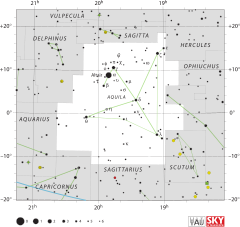Delta Aquilae
| Observation data J2000
| ||
|---|---|---|
| Constellation | Aquila | |
| Right ascension | 19h 25m 29.90139s[1] | |
| Declination | +03° 06′ 53.2061″[1] | |
| Apparent magnitude (V) | 3.365[2] | |
| Characteristics | ||
| Spectral type | F0 IV[3] + K[4] | |
| U−B color index | +0.031[2] | |
| B−V color index | +0.319[2] | |
| R−I color index | +0.16 | |
| Variable type | δ Sct[5] | |
| Absolute magnitude (MV) | 2.46[7] | |
Argument of periastron (ω)(secondary) | 191 ± 14° | |
| Details | ||
| δ Aql Aa | ||
Rotational velocity (v sin i) | 87.3[12] km/s | |
| δ Aql Ab | ||
| Mass | 0.67[4] M☉ | |
| Radius | 0.61[4] R☉ | |
NLTT 47775[13] | ||
| Database references | ||
| SIMBAD | data | |
Delta Aquilae,
Properties
The binary nature of this system was first reported by
The primary member, designated component Aa, is an aging
The secondary, component Ab, is a smaller star with about 67% of the Sun's mass and an estimated 61% of the radius of the Sun.
Naming
This star, along with
On the other hand, Antonín Bečvář includes, with no further explanation, Deneb Okab in his catalogue,[18] meaning the tail of eagle in Arabic; however, the star is situated in the centre of the constellation, which is usually identified with the chest, while the stars ε Aql and ζ Aql have been collectively known as Deneb al Okab by Arabian medieval astronomers,[15] which might suggest that Bečvář's assumption was a misnomer.
In the catalogue of stars in the Calendarium of Al Achsasi al Mouakket, this star was designated Djenubi Menkib al Nesr (منكب ألنسر ألخنوبي – mankib al-nasr al-janúbii), which was translated into Latin as Australior Humerus Vulturis, meaning the southern shoulder of the eagle.[19]
In
This star, together with η Aql, θ Aql, ι Aql, κ Aql and λ Aql, were once part of the now-obsolete constellation Antinous.[22]
References
- ^ S2CID 18759600
- ^ Bibcode:1984SAAOC...8...59C
- ^ doi:10.1086/129562
- ^
- ^
- ^ Bibcode:1967IAUS...30...57E
- ^ S2CID 8642707
- ^ doi:10.1086/115169
- Bibcode:1990A&AS...85.1015M
- S2CID 1106754
- ^ S2CID 118362423
- ^
- Centre de Données astronomiques de Strasbourg, retrieved 2012-02-06
- S2CID 59039482, A35.
- ^ ISBN 0-486-21079-0. Retrieved 2010-12-12.
- ^ Rhoads, Jack W. (November 15, 1971), Technical Memorandum 33-507-A Reduced Star Catalog Containing 537 Named Stars (PDF), Jet Propulsion Laboratory, California Institute of Technology, retrieved 2012-02-06
- ^ Kaler, Jim. "Delta Aql". Retrieved 2017-03-10.
- ^ Bečvář, A. (1951). Atlas Coeli Skalnaté Pleso II - Katalog 1950.0. Přírodovědecké Vydavatelstrí. p. 277. Retrieved 10 March 2017.
- ISBN 978-986-7332-25-7.
- ^ (in Chinese) 香港太空館 - 研究資源 - 亮星中英對照表 Archived September 29, 2009, at the Wayback Machine, Hong Kong Space Museum. Accessed on line November 23, 2010.
- ^ Ian Ridpath's Star Tales - Antinous
External links
- An Atlas of the Universe: Multiple Star Orbits
- Image δ Aquilae

